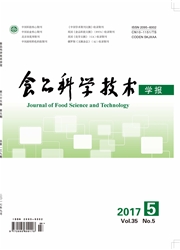

 中文摘要:
中文摘要:
采用固相微萃取一气质联用方法对手工榨汁和机械榨汁的挥发性成分进行分析,分别检测出51和54种挥发性成分,机械榨汁中挥发性物质的总峰面积高于手工榨汁.通过气相色谱一嗅觉检测法(GC-O)分析,发现两种橙汁中呈现气味的化合物分别有31种和29种,机械榨汁中香气强度较高的是丁酸乙酯、辛醛、芳樟醇和癸醛,手工榨汁中香气强度最高的是柠檬烯和芳樟醇.气味轮廓分析发现机械榨汁的橘香最强.手工榨汁的花香最强.机械榨汁除脂肪味外,其他类香气均高于手工榨汁.榨汁这一工艺过程对橙汁的香气有所改变,辛醛和橙香醛这些具有橘香气味的物质含量增加.
 英文摘要:
英文摘要:
Total of 51and 54 volatile compounds of mechanically extracted juice and hand extracted juice were analyzed by solid phase microextraction combined with gas chromatography-mass spectrometry. The total peak area of mechanically extracted juice was higher than that of hand extracted juice. Total of 31 and 29 odor compounds were deteced by GC - Olfactometry. Ethyl butanoate, octanal, linalool, and decanal were the major aroma compounds in mechanically extracted juice. The compounds with strong aroma intensity of hand extracted juice were limonene and linalool. The odor profiles showed that the mechanically extracted juice and hand extracted juice mainly presented citrus odor and flowery odor, respectively. Major group odor of mechanically extracted juice presented higher than that of hand extracted juice except fatty note. The results indicated that the process of extraction could change the orange juice aroma, and the contents of octanal and neral with citrus odor could be increased by mechanical extraction.
 同期刊论文项目
同期刊论文项目
 同项目期刊论文
同项目期刊论文
 期刊信息
期刊信息
